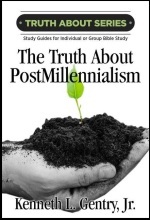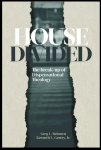HYPERPRETERISM VS. THE GOSPEL (2)
PMW 2025-059 by Kenneth L. Gentry, Jr.
Introduction
This is the second in a three-part series on 1 Corinthians that will be showing that Paul warns that a denial of the physical resurrection ends up denying the gospel of Jesus Christ. This should be a deep concern for any young theologue toying with hyper-preterism and its neo-Gnostic convictions. This charge of neo-Gnosticism arises due to hyper-preterists denying the physical nature of the resurrection body, arguing that the resurrected body is composed of spirit.
In this series I am slowly building my case from Paul’s first letter to the Corinthians. Paul was no hyper-preterist!
Reminder
In my last posting I focused on how Paul’s leading concern for the Corinthians is highlighted in the first verse in the opening of the main body of his letter. There at 1 Corinthians 1:10 we read:
“Now I exhort you, brethren, by the name of our Lord Jesus Christ, that you all agree and that there be no divisions among you, but that you be made complete in the same mind and in the same judgment.”
In that posting I noted that Paul’s core concern (not his only concern) with the confused, squabbling church at Corinth regarded their doctrine. Here at 1:10 we find his first exhortation-clause appearing very early in his epistle. When properly understood, it clearly underscores his theological concerns. We see this in that he urges the Corinthians to “agree,” be of “the same mind” (i.e., “united in your beliefs”), and have “the same judgment” (i.e., thought or viewpoint). These words focus on doctrine, teaching, theology within the church.
Tongues-speaking: Meaning, Purpose, and Cessation
 by Ken Gentry
by Ken Gentry
The position presented within is that tongues-speaking allowed the gift person to speak in a known human language without previously knowing it; tongues brought inspired revelation from God; the gift was a sign confirming the apostolic witness and warning of the coming destruction of Jerusalem; and therefore the gift ceased in the first century.
See more study materials at: www.KennethGentry.com
I also pointed out in that article that commentators agree that Paul’s formal introduction runs from 1:1 to 1:9. And in his introduction, two of its last three verses (vv. 7–8) were designed intentionally to point ahead to his climactic chapter, his enormously important eschatological chapter 15. Significantly, these two verses highlight the doctrine of the second coming of Christ at the end of history. So, in chapter 15 he will provide a detailed discussion of the bodily (physical) resurrection of the dead. This eschatological event is associated with the second coming and is a serious concern regarding the proto-Gnosticism impacting the doctrine of some within that first-century church. [2] Now to:
The business at hand
James Ware, John C. Hurd, Gordon Fee, and other commentators inform us of the basic structure of 1 Corinthians. They have noted that after the introduction-thanksgiving section (1:1–9), the opening of the main body of the letter is found in 1:10–17, and that the main body itself runs from 1:10–15:58, while chapter 16 forms Paul’s conclusion. Fee writes of 1:10: “with this sentence Paul makes an immediate transition from the thanksgiving to the body of the letter proper.”
The eight verses in the 1:10–17 unit serve as an important introduction — especially to the epistle’s first main section (chs. 1–4). Roy Ciampa and Brian Rosner show that this first main section is “marked off as a major unit by the repetition of ‘I appeal to you’ in 1:10 and 4:16.” This four-chapter section deals with the dangers of division and false wisdom (James Ware; Carl Bjerkelund). But in these few verses in chapter 1 (vv. 10–17), we see something that has long been confusing to commentators. Let me explain.
A confusing matter
In his first chapter, verses 10–17 introduce several themes that are vitally important for the Corinthian church: (1) the exhortation to unity (v. 10), (2) the problem of internal divisions within the church (vv. 10–12), (3) Paul’s preaching of the gospel, his speech, and his wisdom (v. 17), and (4) the undermining of the gospel through human wisdom (v. 17). Yet these issues wholly disappear from the rest of the epistle after chapter 4! That is, until they reappear in chapter 15.
We see disunity as a crucial concern in 1:18–4:21 (cf. 3:1–4, 18, 21; 4:18–20). And we also see in these early chapters the themes of Paul’s preaching, speech, and wisdom highlighted by use of the words logos (“word, message,” 1:17, 18; 2:1, 4, 6a, 13) and sophia (“wisdom,” 1:21, 24, 30; 2:1, 4, 5). And in this regard, we also see a strong rejection of human “wisdom” (1:19, 30; 2:4, 5, 6b, 13; 3:19). But again, these issues are wholly absent from chapters 5–14. In those later chapters Paul deals with practical matters and conduct issues, such as immorality (5:1–2), in-church lawsuits (6:1, 12), marriage responsibilities (7:1–3), Christian liberty (8:1–2), worship conduct (11:18-34), etc.
So we must recall how chapters 1–4 relate to the following chapters of the epistle. In my previous article I noted the underlying cause of the divisions troubling the Corinthians was doctrinal disunity. We saw this in 1:10 where Paul urged agreement in their public speaking (to auto legete, he urges them to “say the same thing”), thinking (ho autos nous, “the same mind”), and viewpoint (te aute gnome, “the same judgment”).
This doctrinal concern comes to clear expression toward the end of his first major section. There at 4:16, Paul parallels his initial parakaleo-clause (exhortation-clause) in 1:10 with a second one. Here in 4:16 he writes: “I exhort [parakaleo] you, be imitators of me.” By this he is calling them — again — to doctrinal conformity with his practice and his teaching. We see this in the next verse (4:17) where we read that Timothy “will remind you of my ways [tas hodous mou], which are in Christ, just as I teach [didasko] everywhere in every church.”
The Truth about Postmillennialism By Ken Gentry
By Ken Gentry
A group Bible study guide for explaining the optimistic prophetic hope for this world to be accomplished before Christ’s Second Coming. Establishes the postmillennial system in both the Old and New Testaments. Touches on key eschatological issues, such as creation, covenant, interpretive methodolgy, the great tribulation, the Book of Revelation, the Jewish Temple, and more. It presents and answers the leading objections to postmillennialism.Twelve chapters are ideal for one quarter of Sunday School.
See more study materials at: www.KennethGentry.com
So here Paul is calling the doctrinally disoriented and socially disunified church back to their proper foundation: the gospel that he preaches in every church (cp. 3:10–11). As noted in 1:10, Paul’s first parakaleo calls on them “to speak the same” (to auto legein), i.e., agree in doctrine proclaimed. And we discover there that this involves Christ sending Paul to “preach the gospel” (1:17), which is “the word of the cross” (ho logos … ho tou staurou,1:18), i.e., it is a “word” (or doctrine) concerning the gospel.
But Paul waits until 1 Corinthians 15 to fully define this preached “word” and to emphasize its fundamental significance. There we read:
“Now I make known to you, brethren, the gospel [to euaggelion] which I preached to you [ho eueggelisamen humin], which also you received, in which also you stand, by which also you are saved, if you hold fast the word [logo] which I preached to you [tini logo eueggelisamen humin], unless you believed in vain.” (1 Cor. 15:1–2)
Thus, as noted in my first article, 1:10 summarizes Paul’s “real concern” in the epistle (James Ware, Carl Bjerkelund), which is doctrinal unity. But in the process it also anticipates the fuller definition of the doctrine of the gospel which will eventually be given in 1 Corinthians 15 (the great resurrection chapter), and is summarily stated at 15:1–2.
The enormity of Paul’s concern
So now let us notice his deep concern for them expressed in those two verses (15:1-2): he states that they have had the gospel preached to them, have received it, currently stand in it, and are saved by it. But this is true only if they “hold fast the word” — “unless [they] believed in vain.” [1] This is a serious concern indeed! This doctrinal concern will be fully disclosed and developed in this climactic chapter 15, the goal toward which Paul is pressing.
This is a very real concern for Paul because in 1:10 he calls on “all” to agree in doctrine. This implies that some at Corinth do not agree on doctrine. In fact, in the very next verse (1:11) he notes that “I have been informed concerning you, my brethren, by Chloe’s people, that there are quarrels among you,” apparently over doctrine.
House Divided: The Break-up of Dispensational Theology By Greg Bahnsen and Ken Gentry
By Greg Bahnsen and Ken Gentry
This book presents and defends Christian Reconstruction theology, particularly theonomic ethics and postmillennial eschatology. It does to by responding to dispensationalism’s social and exegetical theology.
For more educational materials: www. KennethGentry.com
Then he actually states that very fact toward the close of his first major division: “some [tines] have become arrogant, as though I were not coming to you” (4:18). And these are arrogant regarding their own prideful teaching (their “word”): “I will come to you soon, if the Lord wills, and I shall find out, not the words [ton logon, literally, “the word” in the singular, i.e., doctrine] of those who are arrogant but their power. For the kingdom of God does not consist in words [ton logon, literally, “the word” in the singular, i.e., doctrine)] but in power” (4:19–20; cp. 2:1–15).
So here Paul wants to discover if the teaching (“word”) of these arrogant people is having an influence in the church, that is, if it is exercising power over the people. Because God’s word as preached by Paul does have power. The problem Paul is countering is that some at Corinth are arrogant in following human wisdom and speech (cp. 1:19–21, 26–31) over against Paul’s teaching (word).
The few, the proud
Significantly, as James Ware notes, Paul’s use of the plural indefinite pronoun “some” (tines) is applied to a group causing division in the church in only three places in the letter: here in 4:18, then later it appears twice in 1 Corinthians 15:
“Now if Christ is preached, that He has been raised from the dead, how do some [tines] among you say that there is no resurrection of the dead?” (1 Cor. 15:12)
“Become sober-minded as you ought, and stop sinning; for some [tines] have no knowledge of God. I speak this to your shame” (1 Cor. 15:34).
This is another line of evidence showing that Paul’s argument is intentionally leading to (i.e., anticipating, foreshadowing) 1 Corinthians 15. And there it is linked specifically to the doctrine of the resurrection of the dead, which Paul deals with in great detail. There Paul asks how “some” can say “there is no resurrection of the dead” (15:12. He then rebukes them, calling on them to be “sober-minded,” to “stop sinning,” noting that this is to their “shame,” showing they “have no knowledge of God.” This is serious indeed!
We must remember, that in 1:10 he urges the Corinthians that they “all say the same thing [to auto legete pantes],” i.e., they all hold the same doctrine, belief, public profession. And it is only in 15:12 and 35 that we discover some who are saying/teaching something different regarding doctrine:
“Now if Christ is preached, that He has been raised from the dead, how do some among you say [legousin based on lego] that there is no resurrection of the dead?” (15:12)
“But someone will say [erei, from lego, “I say”], ‘How are the dead raised?’” (15:35)
Obviously the resurrection of the dead is not Paul’s only concern in 1 Corinthians, but it is his leading concern. For only here in 15:12 and 35 do we find a return to the matter of “some” who are saying different things, i.e., who teach a different doctrine. And Paul deals with the problem in great detail in this 58-verse chapter as the goal of his letter.
As James Ware concludes his study of the anticipatory nature of Paul’s opening chapters:
“I am not arguing for the resurrection as the sole topic or theme within the letter…. But the elements within the epistolary thanksgiving (1:4-9) and the opening parakaleo clause (1:10) pointing forward to chapter 15 are unmistakable, and they reveal that the foremost concern on the apostle’s mind is the denial of the resurrection at Corinth. Moreover, in chapter 15 we will learn that the Christian moral life and the resurrection are inseparably connected, for there Paul will portray his model of cruciform discipleship to Christ as grounded in the hope of the resurrection (15:19, 30-32, 58; cf. 6:12-20) and undermined by its denial (15:32-34). The language and thought of 1:10 reveals that the apostle’s concern is above all a doctrinal and theological one. In chapter 15 we learn the doctrine about which Paul is chiefly concerned: the resurrection of the dead.
Conclusion
So I now must conclude with these uplifting and informative words: “Happy trails to you / until we meet again.” Don’t you miss Roy Rogers?
Notes
1. The conditionality of their salvation here does not undercut the fact that God sovereignly elects men to salvation and sovereignly causes them to persevere in the faith. This conditionality statement notes two things: (1) not all who call upon the name of the Lord are truly saved (Matt. 7:21-23; 1 John 2:19). (2) And, as Charles Hodge taught long ago, warning those who profess faith of this danger is one means by which God causes his elect to persevere.
2. I say “proto-Gnosticism” because full-fledged formal Gnosticism did not arise until the second century. But the seeds for it were sown much earlier and were impacting the Hellenistic believers in Corinth.
Predestination Made Easy
(by Ken Gentry)
A thoroughly biblical, extremely practical, and impressively clear presentation of
the doctrine of absolute predestination.
See more study materials at: www.KennethGentry.com
Kenneth L. Gentry Jr.'s Blog
- Kenneth L. Gentry Jr.'s profile
- 85 followers



